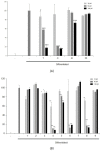Anti-Differentiation Effect of B, D- Seco limonoids of Swietenia mahogani
- PMID: 28539724
- PMCID: PMC5421429
- DOI: 10.4103/0973-1296.204549
Anti-Differentiation Effect of B, D- Seco limonoids of Swietenia mahogani
Abstract
Background: Obesity is a pathological state caused by abnormal or excessive accumulation of fat. Swietenia mahogani JACQ., known as West Indian mahogany, is a medium-sized semi-evergreen tree belonging to Meliaceae. Their seeds are used in Indonesian folk medicine as a treatment for hypertension, diabetes, malaria, and it also has anti-feedant activities. The major components of S. mahogani are B, D-seco limonoids, a type of irregular triterpenes are well known.
Objective: We tried to find the bioactive components, which have the inhibitory activity on adipocyte differentiation from the seeds of S. mahogani.
Material and methods: 3T3-L1 cells, derived from mouse preadipocyte, are widely used in studying adipogenesis process. In this study, we used 3T3-L1 cells to find natural products with the inhibitory activity on adipocyte differentiation. S. mahogani seeds were dried and extracted with 100% MeOH.
Results: The methanolic extract was fractionated by bioassay-guided method to give nine B, D-seco limonoids (1-9) with slight structural modifications. Among nine compounds, compounds 4, 6 and 8 exhibited significant inhibitory effects of cell differentiation on 3T3-L1 cells. Those compounds have tigloyl residue at C-3 in common. Besides, compounds with no tigloyl residue at C-3 showed insignificant effect. Nevertheless, not all compounds with tigloyl residue at C-3 exerted significant inhibitory effect.
Conclusion: These results suggested that tigloyl residue at C-3 may play a role in the anti-proliferative activity on a dipogenesis and the refined extract of S. mahogani may have a potential to be developed as a therapeutic agent to treat obesity.
Summary: Nine irregular seco-limonoids were isolated from Swietenia mahogani.Total extract and CHCl3 fraction of S. mahogani showed the significant inhibitory activities on 3T3-L1 cell differentiation.A tigloyl residue at C-3 in an aglycone may play a role in the anti-proliferative activity on adipogenesis.
Keywords: 3T3-L1; Swietenia mahogani; adipogenesis; obesity; seco-limonoid; structure and activity relationship.
Conflict of interest statement
There are no conflicts of interest.
Figures
Similar articles
-
Rings B,D-seco limonoid antifeedants from Swietenia mahogani.Phytochemistry. 2013 Dec;96:312-7. doi: 10.1016/j.phytochem.2013.08.006. Epub 2013 Sep 10. Phytochemistry. 2013. PMID: 24034555
-
Rings B,D-seco limonoids from the leaves of Swietenia mahogani.Phytochemistry. 2006 Mar;67(5):452-8. doi: 10.1016/j.phytochem.2005.11.020. Epub 2006 Jan 26. Phytochemistry. 2006. PMID: 16442575
-
Acaricidal activity of Swietenia mahogani and Swietenia macrophylla ethanolic extracts against Varroa destructor in honeybee colonies.Exp Parasitol. 2012 Feb;130(2):166-70. doi: 10.1016/j.exppara.2011.10.013. Epub 2011 Nov 12. Exp Parasitol. 2012. PMID: 22101075
-
Insecticidal Triterpenes in Meliaceae: Plant Species, Molecules, and Activities: Part II (Cipadessa, Melia).Int J Mol Sci. 2022 May 10;23(10):5329. doi: 10.3390/ijms23105329. Int J Mol Sci. 2022. PMID: 35628141 Free PMC article. Review.
-
Chemical Structures and Biological Activities of Limonoids from the Genus Swietenia (Meliaceae).Molecules. 2018 Jun 29;23(7):1588. doi: 10.3390/molecules23071588. Molecules. 2018. PMID: 29966275 Free PMC article. Review.
Cited by
-
Triphala, Regulates Adipogenesis through Modulation of Expression of Adipogenic Genes in 3T3-L1 Cell Line.Pharmacogn Mag. 2018 Jan;13(Suppl 4):S834-S839. doi: 10.4103/pm.pm_153_17. Epub 2018 Jan 31. Pharmacogn Mag. 2018. PMID: 29491641 Free PMC article.
References
-
- Park HJ, Cho JY, Kim MK. Anti-obesity effect of Schisandra chinensis in 3T3-L1 cells and high fat diet-induced obese rats. Food Chem. 2012;134:227–34.
-
- Kim CK, Kim M, Oh SD. Effects of Atractylodes macrocephala Koidzumi rhizome on 3T3-L1 adipogenesis and an animal model of obesity. J Ethnopharmacol. 2011;137:396–402. - PubMed
-
- Lee M, Lee HH, Lee JK, Ye SK, Kim SH, Sung SH. Anti-adipogenic activity of compounds isolated from Idesia polycarpa on 3T3-L1 cells. Bioorg Med Chem Lett. 2013;23:3170–4. - PubMed
-
- Wadden TA. Treatment of Obesity by Moderate and Severe Caloric Restriction-Results of Clinical Research Trials. Ann Intern Med. 1993;119:688–93. - PubMed
-
- Green H, Kehinde O. Established Pre-Adipose Cell Line and Its Differentiation in Culture. 2. Factors Affecting Adipose Conversion. Cell. 1975;5:19–27. - PubMed
LinkOut - more resources
Full Text Sources
Other Literature Sources
Miscellaneous




